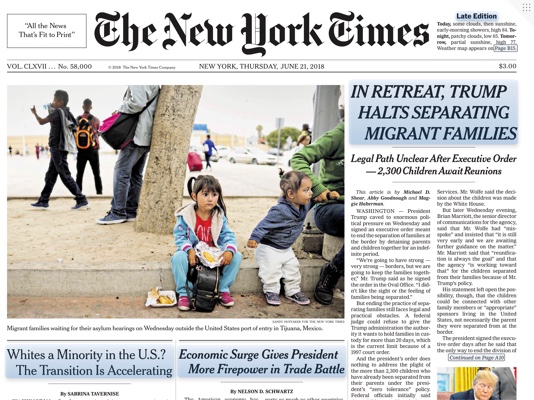What’s Happening on the Border Is a Travesty

The anguished cries of mothers being separated from their children on the U.S. Southwest border recalls earlier travesties visited upon immigrants, native peoples, and the poor. White vigilantes in the early decades of the twentieth century terrorized immigrant, Mexican, native, and working class families in Border States like Arizona and New Mexico. In particular, white mobs in Arizona, organized by local government officials, kidnapped orphaned children being cared for by Mexican families. Over a decade later in 1917, white vigilantes rounded up all the striking miners in Bisbee, Arizona and put them on a train that left them hundreds of miles away in the desert of New Mexico. There was no regard whatsoever for the devastation wrought on struggling families by these repressive actions.
A century earlier when the southwest border, consisting of new states like Alabama and Mississippi, was populated by native communities of Muskogee, Creeks, Cherokee, Choctaw, and Chickasaw, local whites, supported much of the time by the national government, began a genocidal process known as “Indian removal.” Indeed, when President Andrew Jackson signed the actual Indian Removal Act of 1830, the government began a decade-long forced evacuation of these indigenous populations from their homelands to so-called Indian Territory west of the Mississippi. Prior to his presidency, Jackson had a long history, especially in Tennessee, of terrorizing native peoples. In the military operation against the Muskogee, “Jackson’s mercenaries killed hundreds of Muskogee civilians, pursuing without mercy even homeless and starved refugees seeking shelter and safety” (Roxanne Dunbar-Ortiz, An Indigenous Peoples’ History of the United States, p. 99).
During the 1830’s tens of thousands of native peoples were brutally uprooted and marched, often in the dead of winter, across the Mississippi. When even the U.S. Supreme Court ruled in 1832 against such forced relocation, President Jackson defied the Court. The violent removal of these Indian nations continued under Jackson’s successor, Martin Van Buren, concluding in 1838 with the Cherokee being put into detention campus before being forced out of Georgia and Alabama in a winter march, later to be known as the “Trail of Tears.” Over 8,000 of those Cherokee, including women and children, died under horrific conditions. One of the U.S. Army soldiers who later recounted his involvement in this violent uprooting of Cherokee noted: “I fought through the civil war and have seen men shot to pieces and slaughtered by thousands, but the Cherokee removal was the cruelest work I ever knew” (Dunbar-Ortiz, p. 113).
If not as cruel as the 1838 Cherokee removal, the recent forced separation of asylum-seeking and immigrant parents and children at the southwest border has, nonetheless, unleashed a different “trail of tears.” Many of those desperate families have fled from violence in countries like El Salvador, Guatemala, and Honduras, countries where U.S. imperial interventions in the late twentieth and early twenty-first centuries exacerbated harsh conditions confronting the poor. According to a 2015 Doctors Without Borders study of these Central Americans seeking asylum, at least 40 percent had lost a family member to the endemic gang violence plaguing their countries.
While immigration since 2000 has declined, the repressive response by U.S. authorities at the border has increased. Under Barack Obama, whose administration legitimized the coup against the democratically elected President of Honduras, aiding, in the process, a ramping up of violence in that country, deportations rose to their highest level ever. In addition, in the summer of 2014 with a surge in families and unaccompanied minors crossing the border, the Obama Administration used detention centers as a stopgap until the courts intervened to demand their release while cases for asylum were under review.
During the Republican primary campaign, Donald Trump repeatedly and maliciously referred to Mexican “rapists” and “criminals” pouring over the border, necessitating an even harsher regimen, including the building of a wall to prevent further immigration of these brown people from the south. Channeling his hero, Andrew Jackson, Trump longed for reconstituting a white republic by criminalizing those seeking refuge in the United States. Once inside the White House, the Trump Administration began separating families at the border. Starting in 2017 with then secretary of Homeland Secretary, John Kelly, announcing these separations as a “deterrence” through the present Homeland Secretary, Kirstjen Nielsen, defending taking children away from their parents “in the interest of the child,” thousands of children have been essentially kidnapped by a “zero-tolerance” policy. Viewing the parents as “smugglers” of their own children, Attorney General Jeff Sessions vowed in May 2018 to continue family separation, using biblical passages the following month to justify the Administration’s actions.
The hue and cry raised by international human rights agencies denouncing such forced separations, along with reports from the ACLU and immigration attorneys, of hundreds of claims of abuse by the Border Patrol of these children, galvanized an already outraged public that such cruelty against immigrant families must desist. Although Trump was forced to promulgate an executive order on June 20 to keep immigrant families together, the process of reuniting and protecting these families is still in question. Immigrants are still being sent to detention centers where thousands are already languishing in understaffed and overcrowded facilities. Under new orders by a California federal judge on June 26 to reunite these separated families, the deliberate lack of full compliance and/or incompetence by various Trump agencies from within Homeland Security and the Office of Refugee Resettlement suggests this trail of tears will, unfortunately, continue.